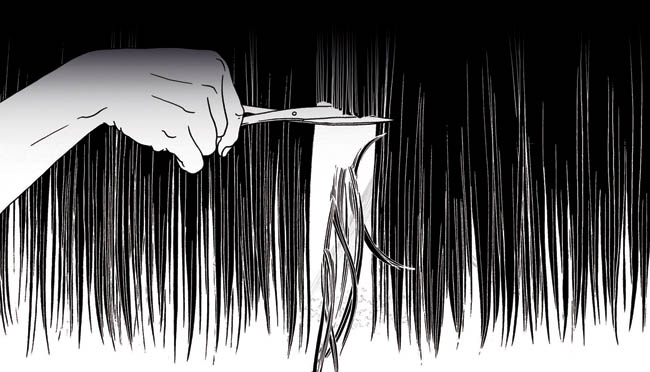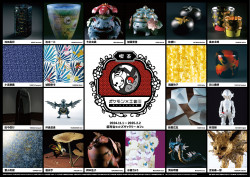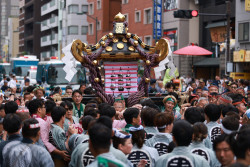
February 4, 2010
Tabaimo
A leading contemporary artist dissects Japan’s “lost generation”
By Metropolis
Originally published on metropolis.co.jp on February 2010

Yudangami, 2009, video installation
Courtesy of The Artist and Gallery Koyanagi
For the Frankfurt School of Marxist cultural thinkers, the difference between “negative” and “affirmative culture” was important: as long as society languished in an imperfect, pre-utopian stage, the only true art was a disturbing or critical one that made people dissatisfied with society and drove them to change it. Affirmative art merely reinforced what they saw as a repressive status quo.
There is a little of this ideological attitude behind much avant-garde art, including “Tabaimo: Danmen no Sedai,” the new exhibition by one of the most touted contemporary artists in Japan.
Since breaking onto the scene as the youngest entrant in the Yokohama Triennale in 2001, Tabaimo has built up a strong reputation with her hand-drawn animated works that give a surreal and often strongly critical twist to typical Japanese urban scenes and situations.

Fragment (installation view at Yokohama Museum of Art), 2009, video installation
Courtesy of The Artist and Gallery Koyanagi
The current exhibition in the voluminous spaces of the Yokohama Museum of Art is an opportunity for Tabaimo, now in her mid-30s, to cement her growing status. Accordingly, she has come up with a suitably grand theme that riffs on Japan’s generation gaps and sense of social unease.
The title, “Danmen no Sedai” (“Crosscut Generation”), is a pun on “Dankai no Sedai” (“Solidarity Generation”), a well-known phrase describing the radicalized and politically active baby boomers that came of age in the ’60s. While the Solidarity Generation banded together in an attempt to change the world, the Crosscut Generation—those who, like Tabaimo herself, reached adulthood after the Bubble—are more wrapped up in themselves. She even uses the analogy of sushi rolls cut into thin individual slices to get her point across.
“Rather than being one indiscernible part of some comprehensive totality, we’d rather remain a single slice, however thin and two-dimensional, with all elements in plain view,” she writes in the exhibition catalogue.
The essential difference seems to be between the person as part of a social macrocosm versus the individual as a self-absorbed microcosm, an idea which resonates with a wide range of contemporary phenomena, from the reclusive hikikomori to the garrulous Twitterer.
The idea of social atomization is strongly realized in danDAN, a video installation on three connected screens that presents a cross-section view of a danchi public housing apartment seen from above. Although dwelling close together, the figures in the individual apartments are clearly self-obsessed and oblivious of each other.

danDAN, 2009, video installation
Courtesy of The Artist and Gallery Koyanagi
Other installations like Blow and Fragment take the human body as their subject, showing various mutations, dissections and visual analogies. In the stunning Fragment, the figure of a naked man goes through several changes before being dismembered section by section, with each fragment appearing to drop away below the viewer. This unraveling of the human form leaves one with a sense that the individual is both everything and nothing.
Perhaps the most visually arresting piece is Yudangami (“Careless Hair”), which grew out of the serialized novel that Tabaimo was invited to illustrate in the pages of the Asahi Shimbun. The work presents us with offbeat aspects of a minor character—a prostitute—framed through a curtain of hair that is projected onto a large curved screen. As things take an increasingly surrealistic turn, the sense of voyeuristic intimacy merges with something more sinister.
The same free-associative approach is also evident in the large number of pen and ink illustrations taken from the Asahi serial. These mix impressionistic elements of the story together in a dream-like way, but Tabaimo’s melodious lines give each drawing a surprisingly clean and sculptural quality.
This is a powerful and interesting exhibition that combines a disquieting sense of Japan’s deepening social malaise with an impressive flow of oddball imagery. As such, it should keep Tabaimo’s edgy artistic star firmly in the ascendant.
Yokohama Museum of Art
Tabaimo: Cross-Section of a New World. Video installation. Until Mar 3, free (elem and under)/¥400 (MS)/¥700 (HS, univ)/¥1,100 (adult). 3-4-1 Minato Mirai, Nishi-ku, Yokohama. Tel: 045-221-0300. Open Fri-Wed 10am-6pm, closed Thu. Nearest stn: Minato Mirai. www.yaf.or.jp/yma/







